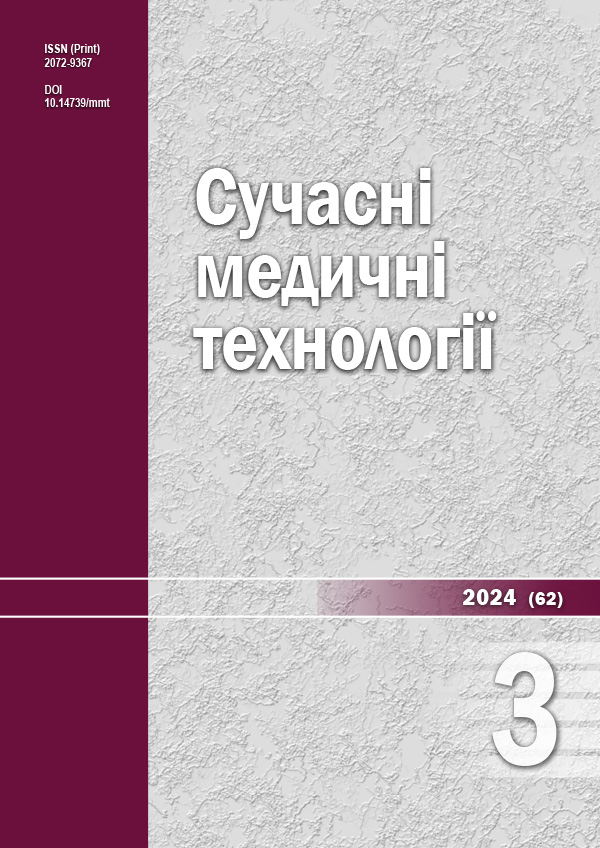Intraoperative oximetry of hollow organs in case of gunshot injuries of the abdomen
DOI:
https://doi.org/10.14739/mmt.2024.3.301137Keywords:
intraoperative oximetry, abdominal injuries, wounds gunshot, hollow organs, DCS tacticsAbstract
The aim of the study is to analyze the application of intraoperative oximetry for assessing the viability of hollow organ segments during the implementation of Damage Control Surgery (DCS) in patients with gunshot abdominal injuries.
Materials and methods. Intraoperative oximetry of the walls of damaged hollow organs was performed in 76 wounded combatants with penetrating gunshot wounds to the abdomen in phase I of DCS, that allowed to determine the state of microcirculation and the viability of the intestinal wall of the injured and other doubtful areas within a few minutes. In phase III of DCS, intraoperative oximetry was performed to assess the viability of questionable areas of both sutured wounds and intestinal stumps after obstructive resections.
Results. The high efficiency of intraoperative oximetry in penetrating gunshot injuries of the abdomen in phase I of DCS tactics has been proven. The oxygenation rate in the SpO2 measurement zone of 95 % and above indicates the viability of intestinal tissue and good conditions for anastomosis formation or wound suturing. The SpO2 level from 89 % to 95 % indicates the questionable viability of the intestinal wall, and below 89 % – the deterioration of microcirculation and a high risk of intestinal wall necrosis development. Repeated intraoperative oximetry in phase III of DCS made it possible to assess the viability of the walls of the small intestine and colon, obstructive stumps of the small intestine and colon, and to optimize surgical tactics with repeated resections of suspicious and non-viable areas of the small intestine and colon. In the main group, the formation of ileo-transverse anastomoses increased by 14.6 % (р = 0.013), and transverso-sigmoanastomoses – by 9.9 % (р = 0.030). This became possible due to the reasoned refusal to form terminal stomas. In the main group, ileostomies were not formed, and in the comparison group they were formed in 5.8 % of the wounded. At the same time, colostomies formation was also reduced by 17.7 % (р = 0.008). The consistent use of intraoperative oximetry in the phase I and III of the DCS tactics made it possible to optimize the surgical tactics, which led to a decrease in complications in the main group by 12.4 % (р = 0.007).
Conclusions. Intraoperative oximetry for gunshot injuries of the abdominal cavity is a simple, fast and effective method that allows to determine the state of microcirculation in the wall of the hollow organ (its viability) and optimize the nature of surgical intervention in phase I of DCS tactics. Intraoperative oximetry in phase III of DCS allows to determine the state of microcirculation in the areas of sutured intestinal injuries, intestinal stumps after obstructive resections performed in favor of the formation of inter-intestinal anastomoses and prevent the development of complications.
References
Shaprynskyi VO, Kanikovskyi OE, Shaprynskyi EV, Martsynkovskyi IP, Ordatii AV, Korobko VA, et al. [Analysis of the results of treatment of small and large intestine damage in combat trauma of the abdomen]. Hospital Surgery. Journal named after L. Kovalchuk. 2022;(4):74-8. Ukrainian. doi: https://doi.org/10.11603/2414-4533.2022.4.13619
Vardhan S, Deshpande SG, Singh A, Aravind Kumar C, Bisen YT, Dighe OR. Techniques for Diagnosing Anastomotic Leaks Intraoperatively in Colorectal Surgeries: A Review. Cureus. 2023;15(1):e34168. doi: https://doi.org/10.7759/cureus.34168
Lurin IA, Humenyuk KV, Tymchuk OB, Popova OM. [The gun-shot woundings of large bowel as a predictor of severe course of fighting abdominal trauma]. Klinichna khirurhiia. 2021;88(7-8):39-43. Ukrainian. doi: https://doi.org/10.26779/2522-1396.2021.7-8.39
Jávor P, Donka T, Horváth T, Sándor L, Török L, Szabó A, et al. Impairment of Mesenteric Perfusion as a Marker of Major Bleeding in Trauma Patients. J Clin Med. 2023;12(10):3571. doi: https://doi.org/10.3390/jcm12103571
Bryski MG, Frenzel Sulyok LG, Kaplan L, Singhal S, Keating JJ. Techniques for intraoperative evaluation of bowel viability in mesenteric ischemia: A review. Am J Surg. 2020;220(2):309-15. doi: https://doi.org/10.1016/j.amjsurg.2020.01.042
Huber W, Zanner R, Schneider G, Schmid R, Lahmer T. Assessment of Regional Perfusion and Organ Function: Less and Non-invasive Techniques. Front Med (Lausanne). 2019;6:50. doi: https://doi.org/10.3389/fmed.2019.00050
Suzuki Y, Yamamoto M, Sugiyama K, Akai T, Suzuki K, Kawamura T, et al. Usefulness of a finger-mounted tissue oximeter with near-infrared spectroscopy for evaluating the intestinal oxygenation and viability in rats. Surg Today. 2021;51(6):931-40. doi: https://doi.org/10.1007/s00595-020-02171-8
Salusjärvi JM, Carpelan-Holmström MA, Louhimo JM, Kruuna O, Scheinin TM. Intraoperative colonic pulse oximetry in left-sided colorectal surgery: can it predict anastomotic leak? Int J Colorectal Dis. 2018;33(3):333-6. doi: https://doi.org/10.1007/s00384-018-2963-4
Omar H, Farag A, Sah VP, Mohsen AA, Mashhour AN. Evaluation of the efficacy of wireless sterilizable pulse oximeter in assessment of bowel viability during surgery. The Egyptian Journal of Surgery. 2020;39(4):879-88. doi: https://doi.org/10.4103/ejs.ejs_100_20
Roberts DJ, Bobrovitz N, Zygun DA, Kirkpatrick AW, Ball CG, Faris PD, et al. Evidence for use of damage control surgery and damage control interventions in civilian trauma patients: a systematic review. World J Emerg Surg. 2021;16(1):10. doi: https://doi.org/10.1186/s13017-021-00352-5
Kashtalyan MA, Kvasnevsky YA, Kvasnevsky OA, Kolotvin AO, Kolotvina LI, Ilyina-Stognienko VY. [Application of "Damage control surgery" for fire injuries of the intestine]. Odesa medical journal. 2021;0(6):38-42. Ukrainian. doi: https://doi.org/10.54229/2226-2008-2021-6-7
Zarutskyi YL, Аslanyan SА, Zhovtonozhko ОІ, Оliinyk YМ, Forostyanyi PP, Honcharuk VS, et al. Anatomical-functional scale of estimation of the trauma severity in wounded persons with thoracoabdominal injuries in environment of conduction of The Joint Armed Forces Operation. Klinichna khirurhiia. 2020;87(1-2):3-7. Ukrainian. doi: https://doi.org/10.26779/2522-1396.2020.1-2.03
Downloads
Additional Files
Published
How to Cite
Issue
Section
License
The work is provided under the terms of the Public Offer and of Creative Commons Attribution-NonCommercial 4.0 International (CC BY-NC 4.0). This license allows an unlimited number of persons to reproduce and share the Licensed Material in all media and formats. Any use of the Licensed Material shall contain an identification of its Creator(s) and must be for non-commercial purposes only.














